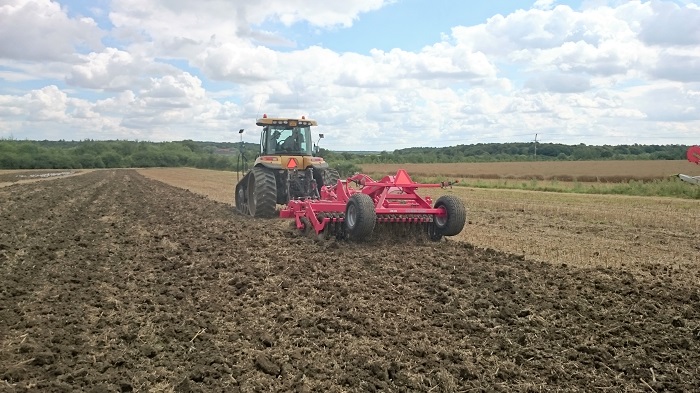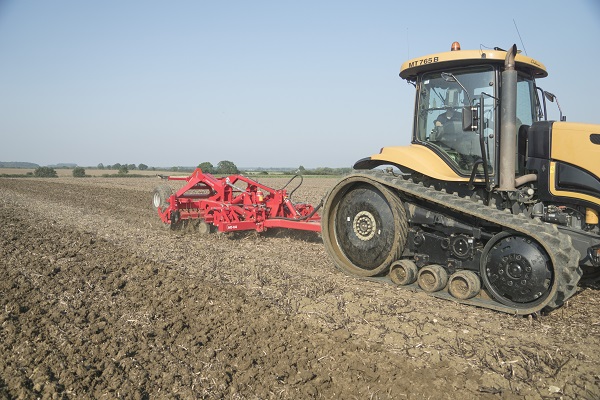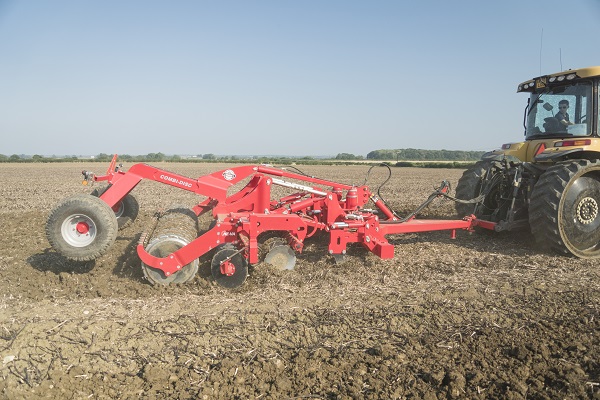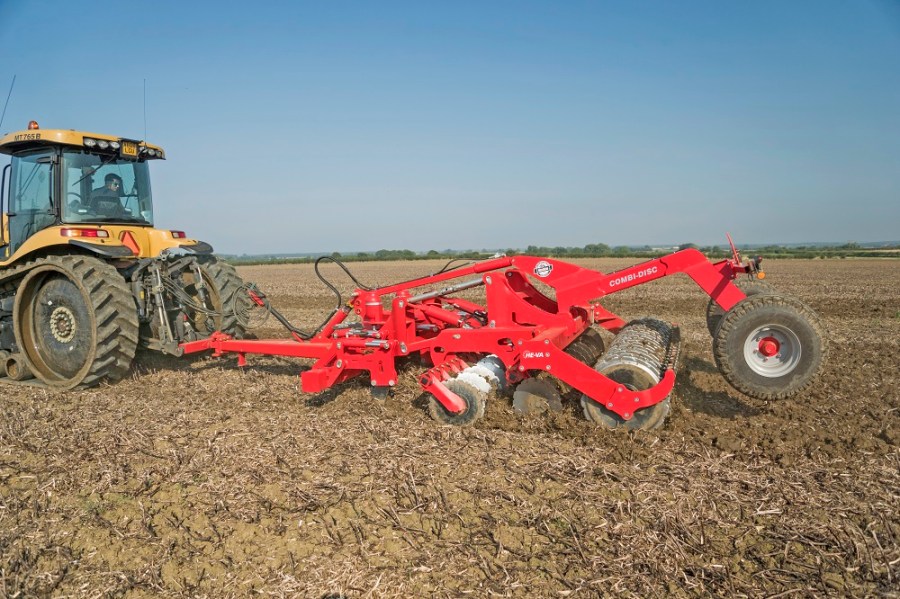A simple change in cultivation practices has seen the time taken for seedbed preparation slashed for one Lincs grower. CPM reports.
I was determined to get things back under control but without detriment to the performance of our crops.
By Rob Jones
There’s been a non-inversion approach to cultivations in place at Hall Farm in Fiskerton, Lincs, for several decades. But grower Henry Ward admits it’s not what many would call a min-till strategy.
“We’ve been fairly old-fashioned in our min-till regime – it regularly saw five or six cultivations passes before we could go in with the drill,” he explains. This involved heavy discs, sub-soilers, cultivator-presses and cultivator drills.

With very heavy clays, the ground has to be turned around when dry without losing all the moisture.
“Really it was maximum tillage. Aside from the obvious cost of this approach, it was way too time-consuming. We’re on extremely heavy clays so the ground has to be turned around when dry without losing all the moisture. If we weren’t careful we’d end up with either baked clods or wet, unworkable slop. We had to find a different way.”
Two passes from a set of heavy discs followed by a sub-soiler and further couple of runs with a tined press were previously the standard approach when preparing ground for wheat. It was fairly obvious that a single tool that combined all these elements could be employed to do the job in one or two swipes.

The 3m, five-leg set-up proves a good match for the farm’s two Challenger track-layers.
“Having done my BASIS and FACTS training and taken over management of our cropping I could see it was our cultivations that were making it hard for our cereals to clear a profit.
“I was determined to get things back under control but without detriment to the performance of our crops.”
So two years ago he trialled various different cultivators – all combinations of discs, tines and presses. “They all did a decent job in their own way but one particular machine stood out for its versatility – He-Va’s CombiDisc. The simple fact that everything on it is hydraulically adjustable means it can be run as a straight sub-soiler or disc-harrow or any combination of the two.”

Used ahead of the winter wheat, the He-Va often goes in straight after the combine, set to create a well drained, corrugated surface.
When priced up against the competition, the Danish-built tillage tool was felt to offer good value for money, especially given its abilities to do a range of different jobs. The 3m, five-leg set-up was a good match for the farm’s two Challenger track-layers and consequently Henry Ward placed an order for a trailed Combi-Disc.
It arrived in mid 2016 and has since been used preparing ground for much of the business’ cereal cropping, with a sub-soiler seeder being used to establish oilseed rape.
“We generally use the He-Va ahead of all our winter wheat. It often goes in straight after the combine. With the legs in to a reasonable depth it creates a well drained, corrugated surface than can stand the weather. We’ll then leave it to get a flush of weeds before spraying off and drilling in late Oct.
“However we can vary the surface finish thanks to the ability to adjust all the different elements, so if we want to drill straight away we’ll set it for a finer tilth.”
That facility to alter everything from the cab is not just used when swapping from crop to crop. With GPS auto-steering on the cultivations tractor, the operator can concentrate on constantly tweaking the settings for the individual soil-engaging parts across the field to get the desired finish, which helps cut down on extra passes.
“The discs are virtually straight so they don’t peel out long, ugly strips of clay like more concave designs. We can set them to move the least amount of soil to produce the tilth we’re looking for – often they’re just scuffing the surface behind the legs,” says Henry Ward.
“The size of the ring press also makes a big difference. Being a bigger diameter than most other machines, it does a better job of packing down the surface and breaking up clods.”
With the 3m machine running at 7-8km/h, workrates generally stand at 1.6-2ha/hr. While this may not seem staggeringly rapid, the fact that the Combi-Disc has eliminated two to three passes from other pieces of equipment means there’s still a considerable time and fuel saving.
“We need to run the He-Va fast enough for the discs to incorporate the trash but slow enough for the subsoiler legs to do a sensible job,” notes Henry Ward.
“Admittedly the Challenger will get through a tank-full of fuel in a decent-length day with the Combi-Disc working to full depth but with the fewer passes from other bits of kit, it’s still much less diesel burnt overall.”
More importantly crop performance hasn’t been compromised as a result of the reduction in tillage intensity. Quite the reverse in fact.
“We’re doing just the same jobs as before – sub-soiling, discing and pressing – but more intelligently so there’s been no detriment to rooting and moisture/nutrient uptake,” he says.
“It’s too early to say if there’s been any impact on overall yields but the crops certainly look better than before.”
Higher workrates on offer from new wider, folding Combi-Disc
He-Va has launched a further upgrade of its trailed Combi-Disc, with the new 450 and 550 models offering wider widths of 4.5m and 5.5m respectively. This ups the output of the single-pass machines for subsoiling, surface cultivation and consolidation.
The new models can be specified with either shearbolt or hydraulic auto-reset legs, but adjustment has been made easier, says UK agent Opico. The depth of both the subsoiler legs and discs can be hydraulically adjusted on-the-move from the tractor seat. This allows the operator to adjust accurately to field conditions on the move. It can also be used as a subsoiler with the discs lifted out of work, a set of discs with the legs lifted up or as a complete one-pass soil cultivator, all controlled from the cab.
There are seven hydraulic reset tines on the 450 Combi-Disc which subsoil to a 350mm depth, with quick-change replaceable points. The 550 version has nine legs. Optional low-disturbance subsoiling tines and points are also available.
The 510mm diameter scalloped Sabre discs which follow the subsoiler legs will cut and mix to a depth of 125mm. The two rows of opposing discs can be hydraulically adjusted and, as they’re pushed deeper in the soil, the angle of the disc is automatically altered, increasing their aggressiveness, to thoroughly mix and chop crop residues. The large, 700mm V-profile press roller which follows consolidates to leave a weatherproof finish, says Opico.
“The new folding Combi-Discs offer rapid ground coverage and increased workrates, with wider working widths and higher horse-power rating,” comments James Woolway of Opico. “Machines can be used for shallow stale seedbed preparation on 180hp tractors, while working up to 350mm deep moving the whole soil profile takes a 450hp tractor.”
There’s an optional minimal disturbance disc opener available. This slices through the surface layer in front of the subsoiling leg to reduce soil burst and ensure weed seeds aren’t brought up to the surface from depth.
The Combi-Disc can work ploughed land prior to drilling or for incorporating stubble and organic matter in a min-till system. A seeder kit can be added to plant cover crops or oilseed rape while cultivating – the seed is distributed behind a soil mat to ensure soil throw from the discs doesn’t disrupt seed distribution.
The 450 and 550 models fold to a transport width of 2.61m and have automatic transport locks for safe and simple road transport. They retail at £50,339 and £62,638 respectively.
Farm Facts
AA Needham and Son, Hall Farm, Fiskerton, near Lincoln
- Farmed area: 445ha
- Cropping: Winter wheat 202ha, OSR 101ha, spring beans 101ha, spring barley 40ha
- Soils: predominantly heavy clays
- Mainline Tractors: Challenger MT 765-B, Claas 55E, Massey Ferguson 6495 and 6480
- Loader: JCB 531-70 Loadall
- Combine: Claas 650 Lexion
- Staff: Henry Ward and one other full-time plus another two at harvest




